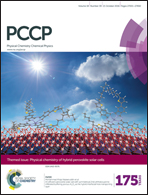Hydrogen bonding and delocalization in the ELF analysis approach
Abstract
Delocalization of the electron density in the proton donor fragment has been studied for 21 complexes, A–H⋯B (A = F, Cl; B = Ne, Ar, CO2, N2, FH, ClH, H2O, PH3, NH3, Cl−, F−, covering the whole range of hydrogen bond strength. The proton donor and proton acceptor fragments are defined by a minimum variance principle achieved by the ELF partition. It is shown that the variance of the proton donor population as well as the charge transfer between the fragments calculated from the ELF partition is always smaller than that evaluated within the QTAIM framework. For both partition schemes, the variance and the charge transfer are correlated with the hydrogen bond strength. It is shown that the variance varies as the square root of the value of the ELF at the hydrogen bond interaction point (i.e. the saddle point at the boundary of the proton donor and proton acceptor moieties)ηvv′ providing a numerical proof of the conjecture that the ELF partition satisfies a minimum variance condition and an explanation of the success of the core valence bifurcation index as an indicator of the hydrogen bond strength. The ELF technique has been then applied to the study of hydrogen bonded crystals for which the variance of the fragment population has been estimated from ηvv′. The systems investigated are KHF2, KDP and ice VIII. The results are consistent with very strong hydrogen bonds in the two former crystals and medium-weak bonding in ice. In ice VIII the variance, and therefore the hydrogen bond strength, increases with pressure yielding a phase transition toward ice X in which the hydrogen bond is characterized as very strong. Our study emphasizes the importance of the partition scheme which defines the proton donor fragment and the role of electron density delocalization between the fragments which is, according to us, often improperly termed as covalence.


 Please wait while we load your content...
Please wait while we load your content...